Comprehensive Financial Analysis Report: Xero Limited, BAO5734 - VU
VerifiedAdded on 2023/06/03
|30
|5880
|68
Report
AI Summary
This report provides a comprehensive financial analysis of Xero Limited, a New Zealand-based cloud accounting software company. It includes a strategic business analysis using PEST analysis to assess political, economic, social, and technological factors affecting Xero. The industry analysis employs Porter's Five Forces to evaluate competitive intensity and attractiveness. The report also features an accounting analysis to identify potential red flags in Xero's financial statements. Furthermore, it conducts a ratio analysis for both cross-sectional and time-series comparisons, alongside a prospective analysis utilizing market multiple approaches and abnormal earnings methods to assess the company's future performance. Based on the overall analysis, the report offers recommendations regarding the investment viability of Xero Limited.
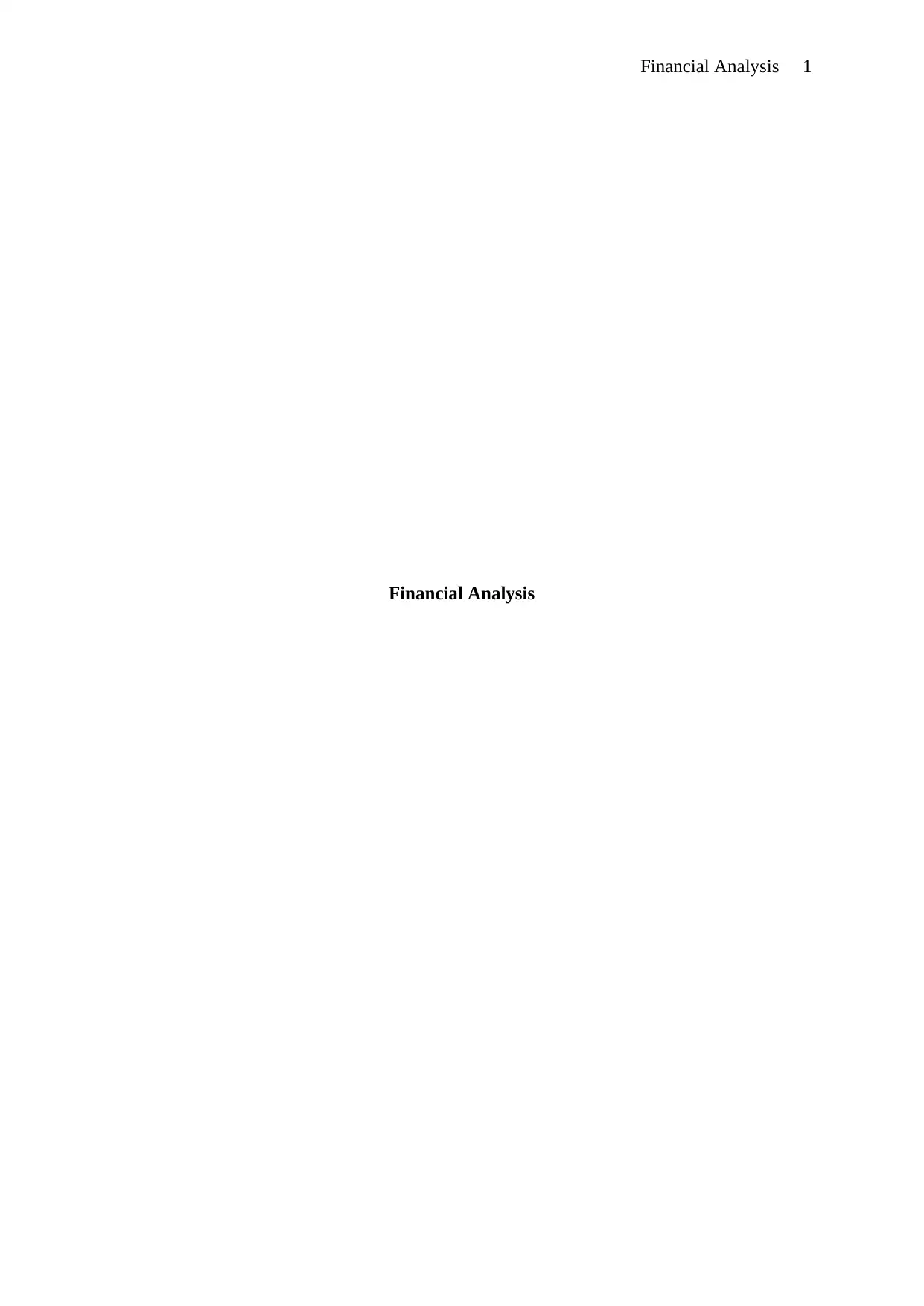
Financial Analysis 1
Financial Analysis
Financial Analysis
Paraphrase This Document
Need a fresh take? Get an instant paraphrase of this document with our AI Paraphraser
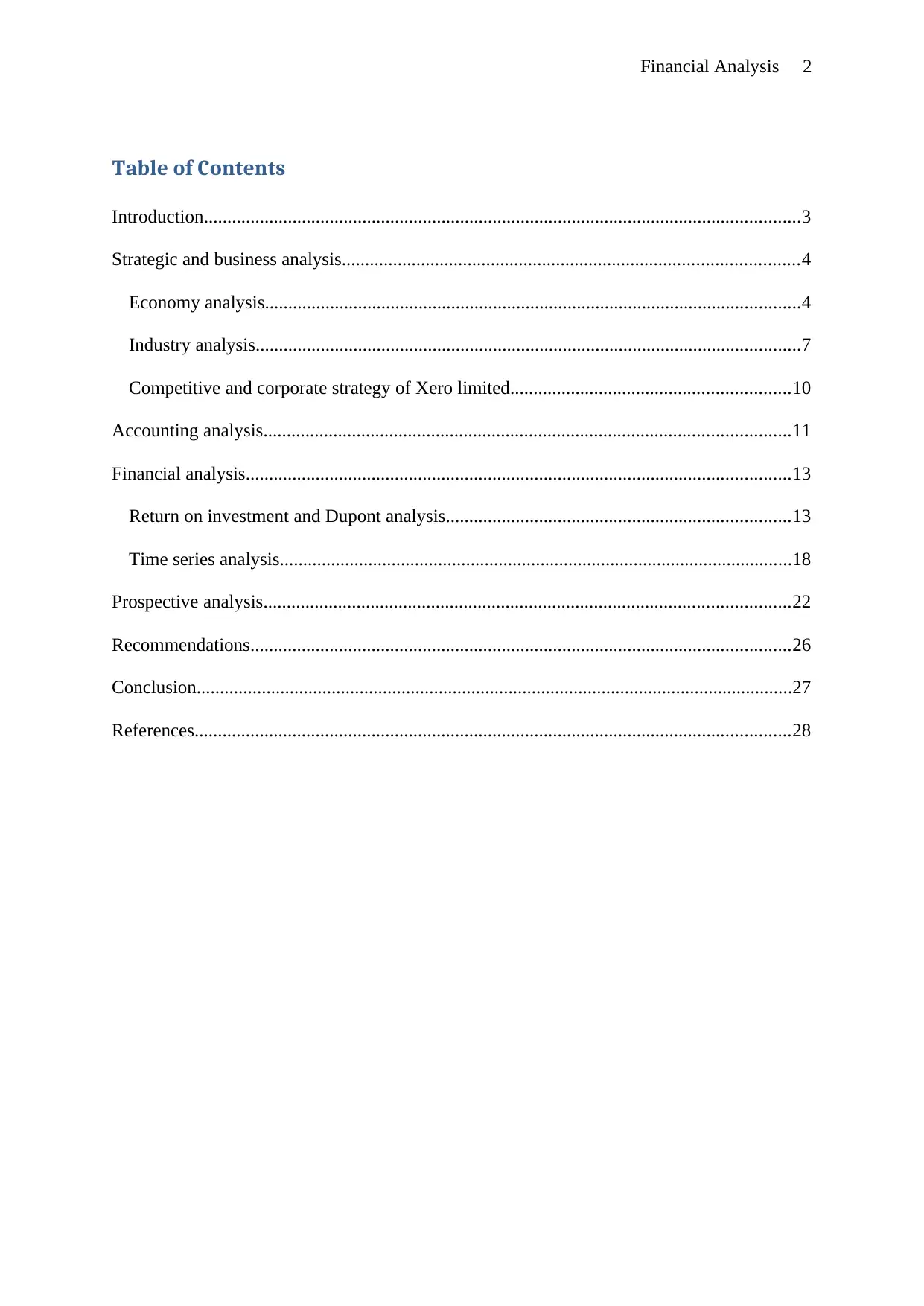
Financial Analysis 2
Table of Contents
Introduction................................................................................................................................3
Strategic and business analysis..................................................................................................4
Economy analysis...................................................................................................................4
Industry analysis.....................................................................................................................7
Competitive and corporate strategy of Xero limited............................................................10
Accounting analysis.................................................................................................................11
Financial analysis.....................................................................................................................13
Return on investment and Dupont analysis..........................................................................13
Time series analysis..............................................................................................................18
Prospective analysis.................................................................................................................22
Recommendations....................................................................................................................26
Conclusion................................................................................................................................27
References................................................................................................................................28
Table of Contents
Introduction................................................................................................................................3
Strategic and business analysis..................................................................................................4
Economy analysis...................................................................................................................4
Industry analysis.....................................................................................................................7
Competitive and corporate strategy of Xero limited............................................................10
Accounting analysis.................................................................................................................11
Financial analysis.....................................................................................................................13
Return on investment and Dupont analysis..........................................................................13
Time series analysis..............................................................................................................18
Prospective analysis.................................................................................................................22
Recommendations....................................................................................................................26
Conclusion................................................................................................................................27
References................................................................................................................................28
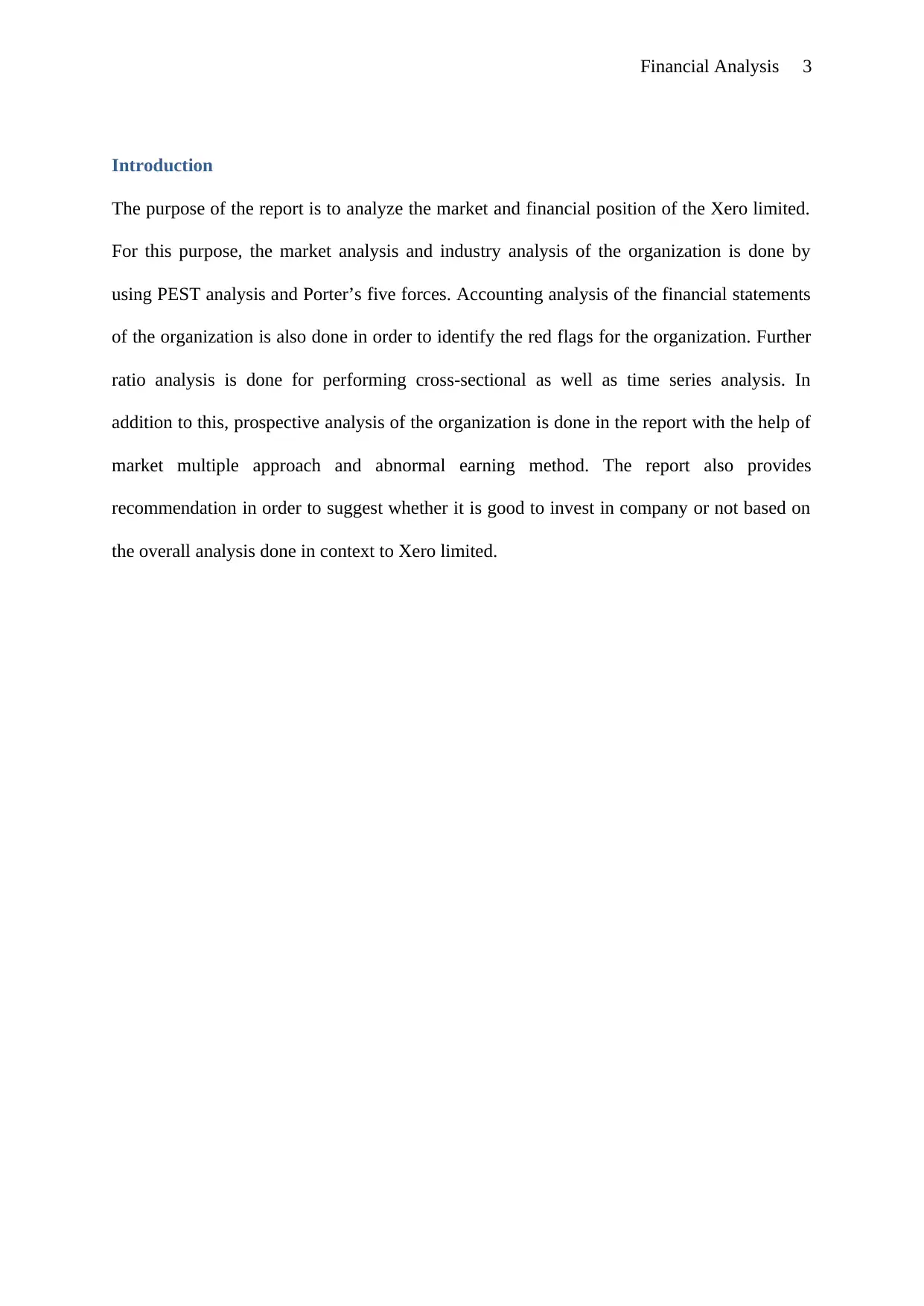
Financial Analysis 3
Introduction
The purpose of the report is to analyze the market and financial position of the Xero limited.
For this purpose, the market analysis and industry analysis of the organization is done by
using PEST analysis and Porter’s five forces. Accounting analysis of the financial statements
of the organization is also done in order to identify the red flags for the organization. Further
ratio analysis is done for performing cross-sectional as well as time series analysis. In
addition to this, prospective analysis of the organization is done in the report with the help of
market multiple approach and abnormal earning method. The report also provides
recommendation in order to suggest whether it is good to invest in company or not based on
the overall analysis done in context to Xero limited.
Introduction
The purpose of the report is to analyze the market and financial position of the Xero limited.
For this purpose, the market analysis and industry analysis of the organization is done by
using PEST analysis and Porter’s five forces. Accounting analysis of the financial statements
of the organization is also done in order to identify the red flags for the organization. Further
ratio analysis is done for performing cross-sectional as well as time series analysis. In
addition to this, prospective analysis of the organization is done in the report with the help of
market multiple approach and abnormal earning method. The report also provides
recommendation in order to suggest whether it is good to invest in company or not based on
the overall analysis done in context to Xero limited.
⊘ This is a preview!⊘
Do you want full access?
Subscribe today to unlock all pages.

Trusted by 1+ million students worldwide
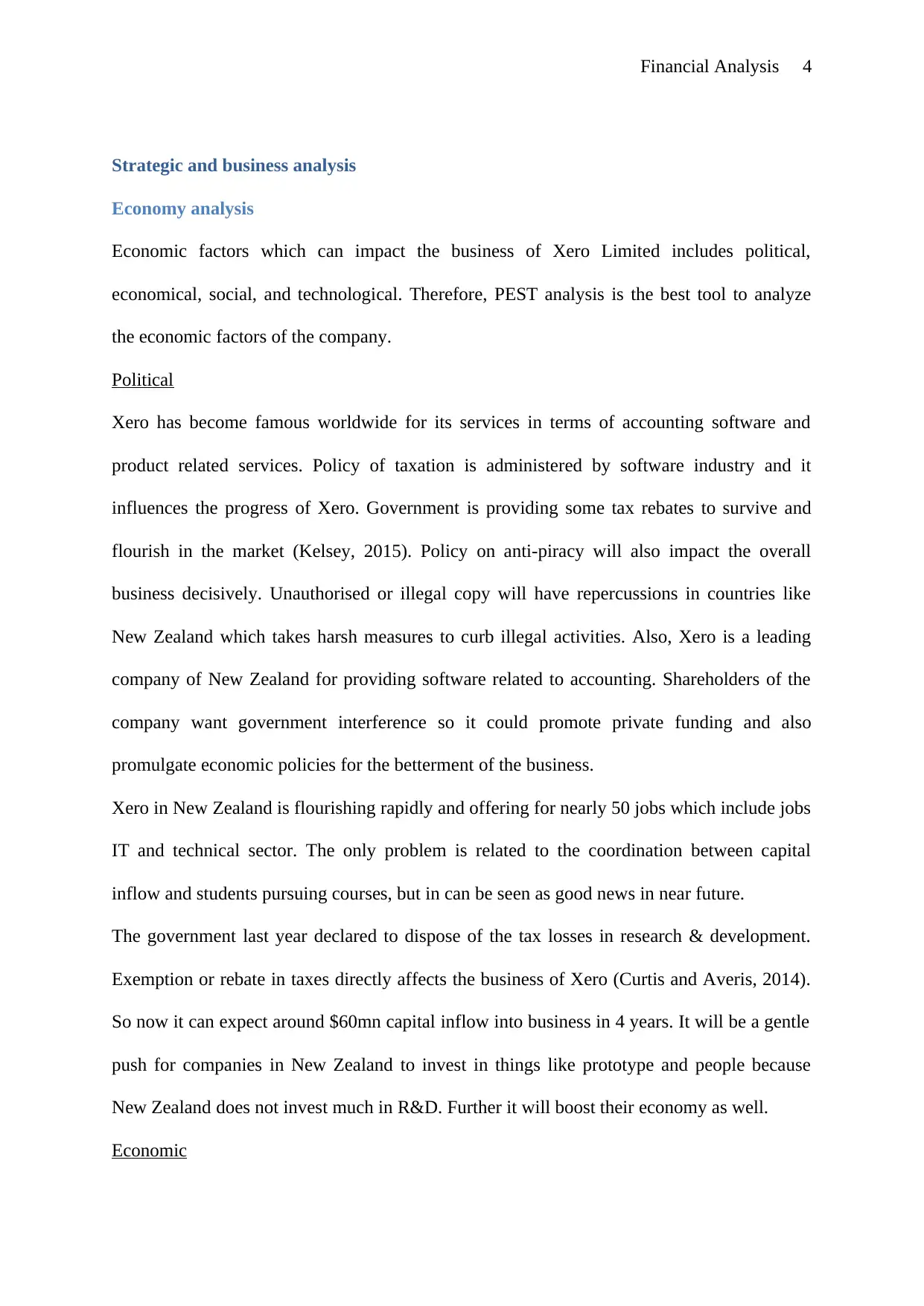
Financial Analysis 4
Strategic and business analysis
Economy analysis
Economic factors which can impact the business of Xero Limited includes political,
economical, social, and technological. Therefore, PEST analysis is the best tool to analyze
the economic factors of the company.
Political
Xero has become famous worldwide for its services in terms of accounting software and
product related services. Policy of taxation is administered by software industry and it
influences the progress of Xero. Government is providing some tax rebates to survive and
flourish in the market (Kelsey, 2015). Policy on anti-piracy will also impact the overall
business decisively. Unauthorised or illegal copy will have repercussions in countries like
New Zealand which takes harsh measures to curb illegal activities. Also, Xero is a leading
company of New Zealand for providing software related to accounting. Shareholders of the
company want government interference so it could promote private funding and also
promulgate economic policies for the betterment of the business.
Xero in New Zealand is flourishing rapidly and offering for nearly 50 jobs which include jobs
IT and technical sector. The only problem is related to the coordination between capital
inflow and students pursuing courses, but in can be seen as good news in near future.
The government last year declared to dispose of the tax losses in research & development.
Exemption or rebate in taxes directly affects the business of Xero (Curtis and Averis, 2014).
So now it can expect around $60mn capital inflow into business in 4 years. It will be a gentle
push for companies in New Zealand to invest in things like prototype and people because
New Zealand does not invest much in R&D. Further it will boost their economy as well.
Economic
Strategic and business analysis
Economy analysis
Economic factors which can impact the business of Xero Limited includes political,
economical, social, and technological. Therefore, PEST analysis is the best tool to analyze
the economic factors of the company.
Political
Xero has become famous worldwide for its services in terms of accounting software and
product related services. Policy of taxation is administered by software industry and it
influences the progress of Xero. Government is providing some tax rebates to survive and
flourish in the market (Kelsey, 2015). Policy on anti-piracy will also impact the overall
business decisively. Unauthorised or illegal copy will have repercussions in countries like
New Zealand which takes harsh measures to curb illegal activities. Also, Xero is a leading
company of New Zealand for providing software related to accounting. Shareholders of the
company want government interference so it could promote private funding and also
promulgate economic policies for the betterment of the business.
Xero in New Zealand is flourishing rapidly and offering for nearly 50 jobs which include jobs
IT and technical sector. The only problem is related to the coordination between capital
inflow and students pursuing courses, but in can be seen as good news in near future.
The government last year declared to dispose of the tax losses in research & development.
Exemption or rebate in taxes directly affects the business of Xero (Curtis and Averis, 2014).
So now it can expect around $60mn capital inflow into business in 4 years. It will be a gentle
push for companies in New Zealand to invest in things like prototype and people because
New Zealand does not invest much in R&D. Further it will boost their economy as well.
Economic
Paraphrase This Document
Need a fresh take? Get an instant paraphrase of this document with our AI Paraphraser
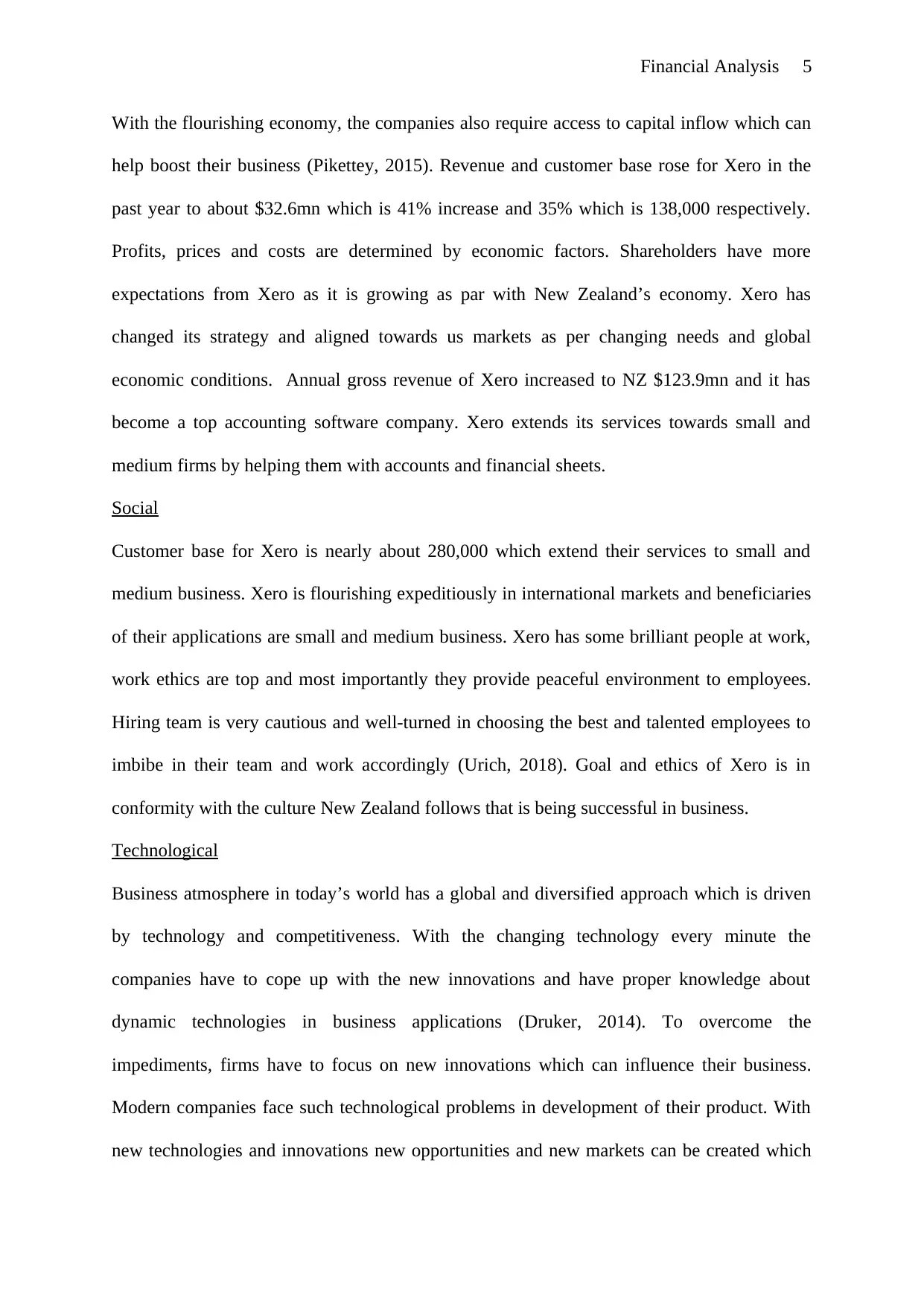
Financial Analysis 5
With the flourishing economy, the companies also require access to capital inflow which can
help boost their business (Pikettey, 2015). Revenue and customer base rose for Xero in the
past year to about $32.6mn which is 41% increase and 35% which is 138,000 respectively.
Profits, prices and costs are determined by economic factors. Shareholders have more
expectations from Xero as it is growing as par with New Zealand’s economy. Xero has
changed its strategy and aligned towards us markets as per changing needs and global
economic conditions. Annual gross revenue of Xero increased to NZ $123.9mn and it has
become a top accounting software company. Xero extends its services towards small and
medium firms by helping them with accounts and financial sheets.
Social
Customer base for Xero is nearly about 280,000 which extend their services to small and
medium business. Xero is flourishing expeditiously in international markets and beneficiaries
of their applications are small and medium business. Xero has some brilliant people at work,
work ethics are top and most importantly they provide peaceful environment to employees.
Hiring team is very cautious and well-turned in choosing the best and talented employees to
imbibe in their team and work accordingly (Urich, 2018). Goal and ethics of Xero is in
conformity with the culture New Zealand follows that is being successful in business.
Technological
Business atmosphere in today’s world has a global and diversified approach which is driven
by technology and competitiveness. With the changing technology every minute the
companies have to cope up with the new innovations and have proper knowledge about
dynamic technologies in business applications (Druker, 2014). To overcome the
impediments, firms have to focus on new innovations which can influence their business.
Modern companies face such technological problems in development of their product. With
new technologies and innovations new opportunities and new markets can be created which
With the flourishing economy, the companies also require access to capital inflow which can
help boost their business (Pikettey, 2015). Revenue and customer base rose for Xero in the
past year to about $32.6mn which is 41% increase and 35% which is 138,000 respectively.
Profits, prices and costs are determined by economic factors. Shareholders have more
expectations from Xero as it is growing as par with New Zealand’s economy. Xero has
changed its strategy and aligned towards us markets as per changing needs and global
economic conditions. Annual gross revenue of Xero increased to NZ $123.9mn and it has
become a top accounting software company. Xero extends its services towards small and
medium firms by helping them with accounts and financial sheets.
Social
Customer base for Xero is nearly about 280,000 which extend their services to small and
medium business. Xero is flourishing expeditiously in international markets and beneficiaries
of their applications are small and medium business. Xero has some brilliant people at work,
work ethics are top and most importantly they provide peaceful environment to employees.
Hiring team is very cautious and well-turned in choosing the best and talented employees to
imbibe in their team and work accordingly (Urich, 2018). Goal and ethics of Xero is in
conformity with the culture New Zealand follows that is being successful in business.
Technological
Business atmosphere in today’s world has a global and diversified approach which is driven
by technology and competitiveness. With the changing technology every minute the
companies have to cope up with the new innovations and have proper knowledge about
dynamic technologies in business applications (Druker, 2014). To overcome the
impediments, firms have to focus on new innovations which can influence their business.
Modern companies face such technological problems in development of their product. With
new technologies and innovations new opportunities and new markets can be created which
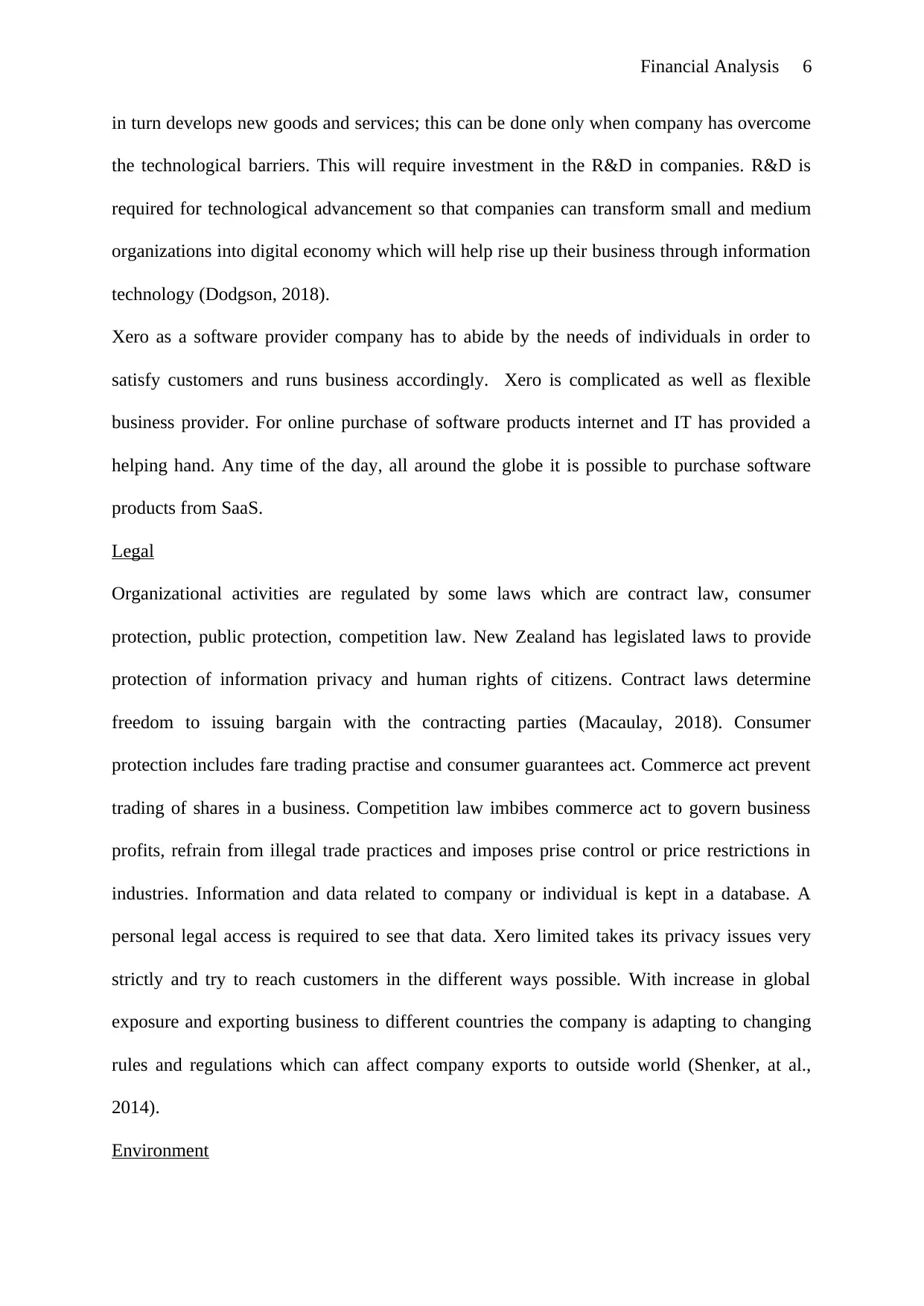
Financial Analysis 6
in turn develops new goods and services; this can be done only when company has overcome
the technological barriers. This will require investment in the R&D in companies. R&D is
required for technological advancement so that companies can transform small and medium
organizations into digital economy which will help rise up their business through information
technology (Dodgson, 2018).
Xero as a software provider company has to abide by the needs of individuals in order to
satisfy customers and runs business accordingly. Xero is complicated as well as flexible
business provider. For online purchase of software products internet and IT has provided a
helping hand. Any time of the day, all around the globe it is possible to purchase software
products from SaaS.
Legal
Organizational activities are regulated by some laws which are contract law, consumer
protection, public protection, competition law. New Zealand has legislated laws to provide
protection of information privacy and human rights of citizens. Contract laws determine
freedom to issuing bargain with the contracting parties (Macaulay, 2018). Consumer
protection includes fare trading practise and consumer guarantees act. Commerce act prevent
trading of shares in a business. Competition law imbibes commerce act to govern business
profits, refrain from illegal trade practices and imposes prise control or price restrictions in
industries. Information and data related to company or individual is kept in a database. A
personal legal access is required to see that data. Xero limited takes its privacy issues very
strictly and try to reach customers in the different ways possible. With increase in global
exposure and exporting business to different countries the company is adapting to changing
rules and regulations which can affect company exports to outside world (Shenker, at al.,
2014).
Environment
in turn develops new goods and services; this can be done only when company has overcome
the technological barriers. This will require investment in the R&D in companies. R&D is
required for technological advancement so that companies can transform small and medium
organizations into digital economy which will help rise up their business through information
technology (Dodgson, 2018).
Xero as a software provider company has to abide by the needs of individuals in order to
satisfy customers and runs business accordingly. Xero is complicated as well as flexible
business provider. For online purchase of software products internet and IT has provided a
helping hand. Any time of the day, all around the globe it is possible to purchase software
products from SaaS.
Legal
Organizational activities are regulated by some laws which are contract law, consumer
protection, public protection, competition law. New Zealand has legislated laws to provide
protection of information privacy and human rights of citizens. Contract laws determine
freedom to issuing bargain with the contracting parties (Macaulay, 2018). Consumer
protection includes fare trading practise and consumer guarantees act. Commerce act prevent
trading of shares in a business. Competition law imbibes commerce act to govern business
profits, refrain from illegal trade practices and imposes prise control or price restrictions in
industries. Information and data related to company or individual is kept in a database. A
personal legal access is required to see that data. Xero limited takes its privacy issues very
strictly and try to reach customers in the different ways possible. With increase in global
exposure and exporting business to different countries the company is adapting to changing
rules and regulations which can affect company exports to outside world (Shenker, at al.,
2014).
Environment
⊘ This is a preview!⊘
Do you want full access?
Subscribe today to unlock all pages.

Trusted by 1+ million students worldwide
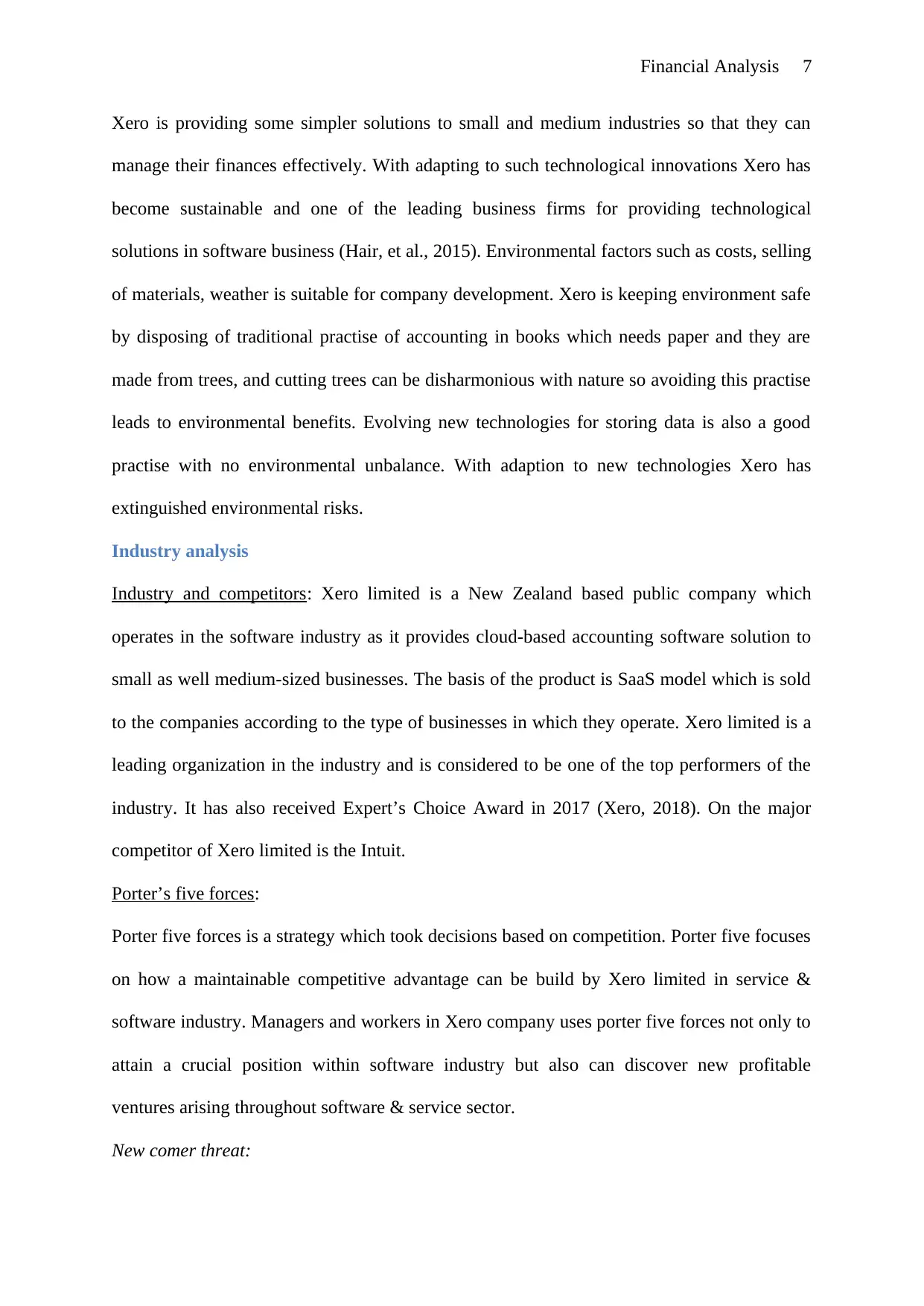
Financial Analysis 7
Xero is providing some simpler solutions to small and medium industries so that they can
manage their finances effectively. With adapting to such technological innovations Xero has
become sustainable and one of the leading business firms for providing technological
solutions in software business (Hair, et al., 2015). Environmental factors such as costs, selling
of materials, weather is suitable for company development. Xero is keeping environment safe
by disposing of traditional practise of accounting in books which needs paper and they are
made from trees, and cutting trees can be disharmonious with nature so avoiding this practise
leads to environmental benefits. Evolving new technologies for storing data is also a good
practise with no environmental unbalance. With adaption to new technologies Xero has
extinguished environmental risks.
Industry analysis
Industry and competitors: Xero limited is a New Zealand based public company which
operates in the software industry as it provides cloud-based accounting software solution to
small as well medium-sized businesses. The basis of the product is SaaS model which is sold
to the companies according to the type of businesses in which they operate. Xero limited is a
leading organization in the industry and is considered to be one of the top performers of the
industry. It has also received Expert’s Choice Award in 2017 (Xero, 2018). On the major
competitor of Xero limited is the Intuit.
Porter’s five forces:
Porter five forces is a strategy which took decisions based on competition. Porter five focuses
on how a maintainable competitive advantage can be build by Xero limited in service &
software industry. Managers and workers in Xero company uses porter five forces not only to
attain a crucial position within software industry but also can discover new profitable
ventures arising throughout software & service sector.
New comer threat:
Xero is providing some simpler solutions to small and medium industries so that they can
manage their finances effectively. With adapting to such technological innovations Xero has
become sustainable and one of the leading business firms for providing technological
solutions in software business (Hair, et al., 2015). Environmental factors such as costs, selling
of materials, weather is suitable for company development. Xero is keeping environment safe
by disposing of traditional practise of accounting in books which needs paper and they are
made from trees, and cutting trees can be disharmonious with nature so avoiding this practise
leads to environmental benefits. Evolving new technologies for storing data is also a good
practise with no environmental unbalance. With adaption to new technologies Xero has
extinguished environmental risks.
Industry analysis
Industry and competitors: Xero limited is a New Zealand based public company which
operates in the software industry as it provides cloud-based accounting software solution to
small as well medium-sized businesses. The basis of the product is SaaS model which is sold
to the companies according to the type of businesses in which they operate. Xero limited is a
leading organization in the industry and is considered to be one of the top performers of the
industry. It has also received Expert’s Choice Award in 2017 (Xero, 2018). On the major
competitor of Xero limited is the Intuit.
Porter’s five forces:
Porter five forces is a strategy which took decisions based on competition. Porter five focuses
on how a maintainable competitive advantage can be build by Xero limited in service &
software industry. Managers and workers in Xero company uses porter five forces not only to
attain a crucial position within software industry but also can discover new profitable
ventures arising throughout software & service sector.
New comer threat:
Paraphrase This Document
Need a fresh take? Get an instant paraphrase of this document with our AI Paraphraser
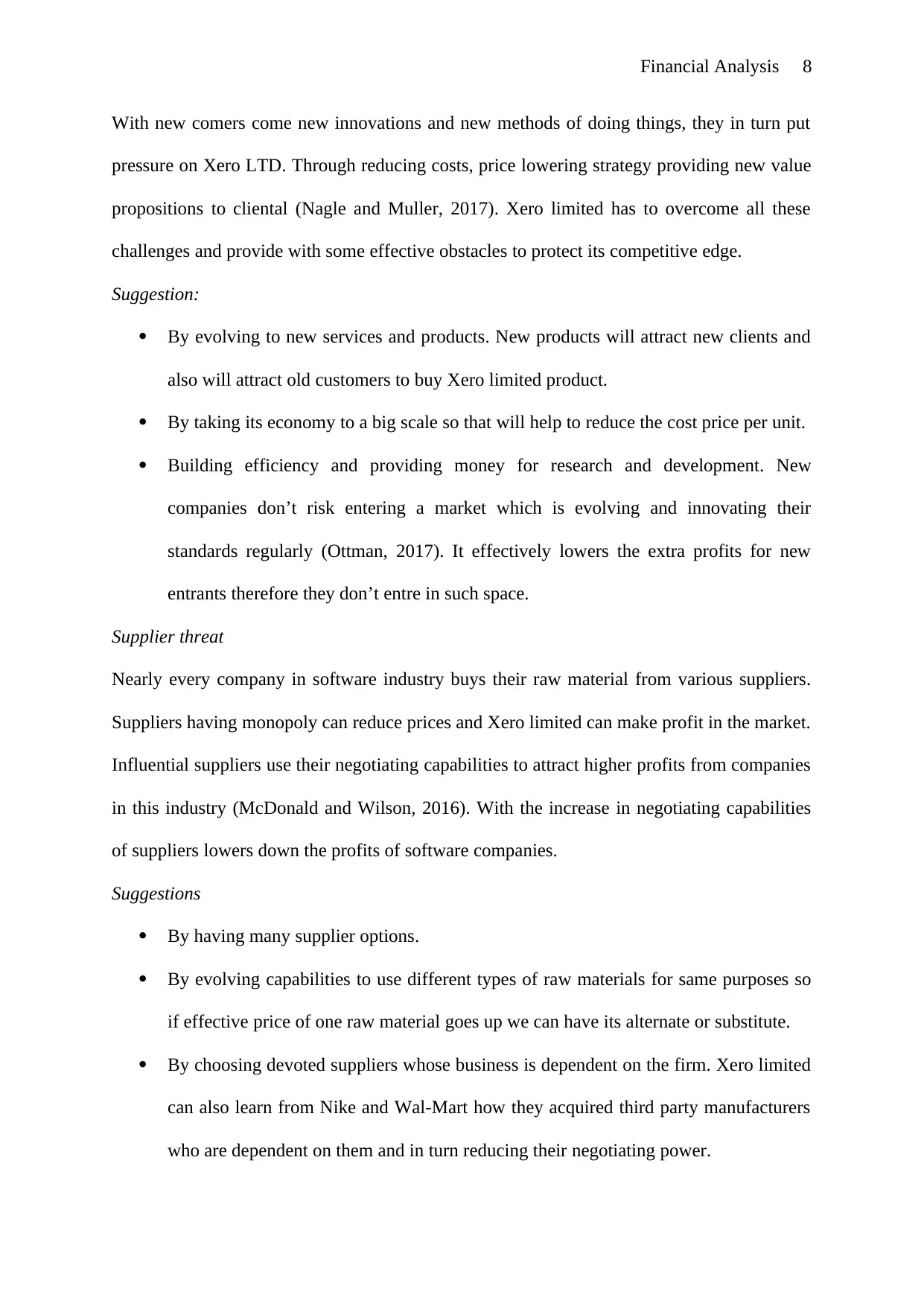
Financial Analysis 8
With new comers come new innovations and new methods of doing things, they in turn put
pressure on Xero LTD. Through reducing costs, price lowering strategy providing new value
propositions to cliental (Nagle and Muller, 2017). Xero limited has to overcome all these
challenges and provide with some effective obstacles to protect its competitive edge.
Suggestion:
By evolving to new services and products. New products will attract new clients and
also will attract old customers to buy Xero limited product.
By taking its economy to a big scale so that will help to reduce the cost price per unit.
Building efficiency and providing money for research and development. New
companies don’t risk entering a market which is evolving and innovating their
standards regularly (Ottman, 2017). It effectively lowers the extra profits for new
entrants therefore they don’t entre in such space.
Supplier threat
Nearly every company in software industry buys their raw material from various suppliers.
Suppliers having monopoly can reduce prices and Xero limited can make profit in the market.
Influential suppliers use their negotiating capabilities to attract higher profits from companies
in this industry (McDonald and Wilson, 2016). With the increase in negotiating capabilities
of suppliers lowers down the profits of software companies.
Suggestions
By having many supplier options.
By evolving capabilities to use different types of raw materials for same purposes so
if effective price of one raw material goes up we can have its alternate or substitute.
By choosing devoted suppliers whose business is dependent on the firm. Xero limited
can also learn from Nike and Wal-Mart how they acquired third party manufacturers
who are dependent on them and in turn reducing their negotiating power.
With new comers come new innovations and new methods of doing things, they in turn put
pressure on Xero LTD. Through reducing costs, price lowering strategy providing new value
propositions to cliental (Nagle and Muller, 2017). Xero limited has to overcome all these
challenges and provide with some effective obstacles to protect its competitive edge.
Suggestion:
By evolving to new services and products. New products will attract new clients and
also will attract old customers to buy Xero limited product.
By taking its economy to a big scale so that will help to reduce the cost price per unit.
Building efficiency and providing money for research and development. New
companies don’t risk entering a market which is evolving and innovating their
standards regularly (Ottman, 2017). It effectively lowers the extra profits for new
entrants therefore they don’t entre in such space.
Supplier threat
Nearly every company in software industry buys their raw material from various suppliers.
Suppliers having monopoly can reduce prices and Xero limited can make profit in the market.
Influential suppliers use their negotiating capabilities to attract higher profits from companies
in this industry (McDonald and Wilson, 2016). With the increase in negotiating capabilities
of suppliers lowers down the profits of software companies.
Suggestions
By having many supplier options.
By evolving capabilities to use different types of raw materials for same purposes so
if effective price of one raw material goes up we can have its alternate or substitute.
By choosing devoted suppliers whose business is dependent on the firm. Xero limited
can also learn from Nike and Wal-Mart how they acquired third party manufacturers
who are dependent on them and in turn reducing their negotiating power.

Financial Analysis 9
Negotiating capacity of the buyer
Buyers are cunning as they always wanted to buy good products at cheap prices. This put
profitability of Xero limited in doldrums. When customer base will be smaller higher will be
their bargaining power and higher will be their capabilities to fetch discounts thus reducing
profits in long run (Kirschen and Strbac, 2018).
Suggestion
By increasing their cliental. It can help in two ways it will reduce bargaining power of
buyers and provide a chance to organize its sales and production department.
By evolving with new innovations and products. Customers avail discounts on old
products but if they are provided with new technology then their bargain will be less
effective.
Risk alternate product or services
When a new innovation satisfies customer needs in different ways, industries profit decreases
(Slater, et al., 2014). For example, service like Google drive and drop box provide alternate to
storage and Hardware disks. The fear of alternate product or service is high if its value in
very different from that of present value.
Suggestion
By providing best service rather than focusing on best products.
By understanding the need of customer rather than selling product to customer.
By giving flexible cost for customers.
Competition among existing opponents
If competition among rivals is intense then it will reduce profits of companies (Cooper,
2017). Xero limited works in a competitive market. This in long run reduces profits of
industry.
Suggestion
Negotiating capacity of the buyer
Buyers are cunning as they always wanted to buy good products at cheap prices. This put
profitability of Xero limited in doldrums. When customer base will be smaller higher will be
their bargaining power and higher will be their capabilities to fetch discounts thus reducing
profits in long run (Kirschen and Strbac, 2018).
Suggestion
By increasing their cliental. It can help in two ways it will reduce bargaining power of
buyers and provide a chance to organize its sales and production department.
By evolving with new innovations and products. Customers avail discounts on old
products but if they are provided with new technology then their bargain will be less
effective.
Risk alternate product or services
When a new innovation satisfies customer needs in different ways, industries profit decreases
(Slater, et al., 2014). For example, service like Google drive and drop box provide alternate to
storage and Hardware disks. The fear of alternate product or service is high if its value in
very different from that of present value.
Suggestion
By providing best service rather than focusing on best products.
By understanding the need of customer rather than selling product to customer.
By giving flexible cost for customers.
Competition among existing opponents
If competition among rivals is intense then it will reduce profits of companies (Cooper,
2017). Xero limited works in a competitive market. This in long run reduces profits of
industry.
Suggestion
⊘ This is a preview!⊘
Do you want full access?
Subscribe today to unlock all pages.

Trusted by 1+ million students worldwide
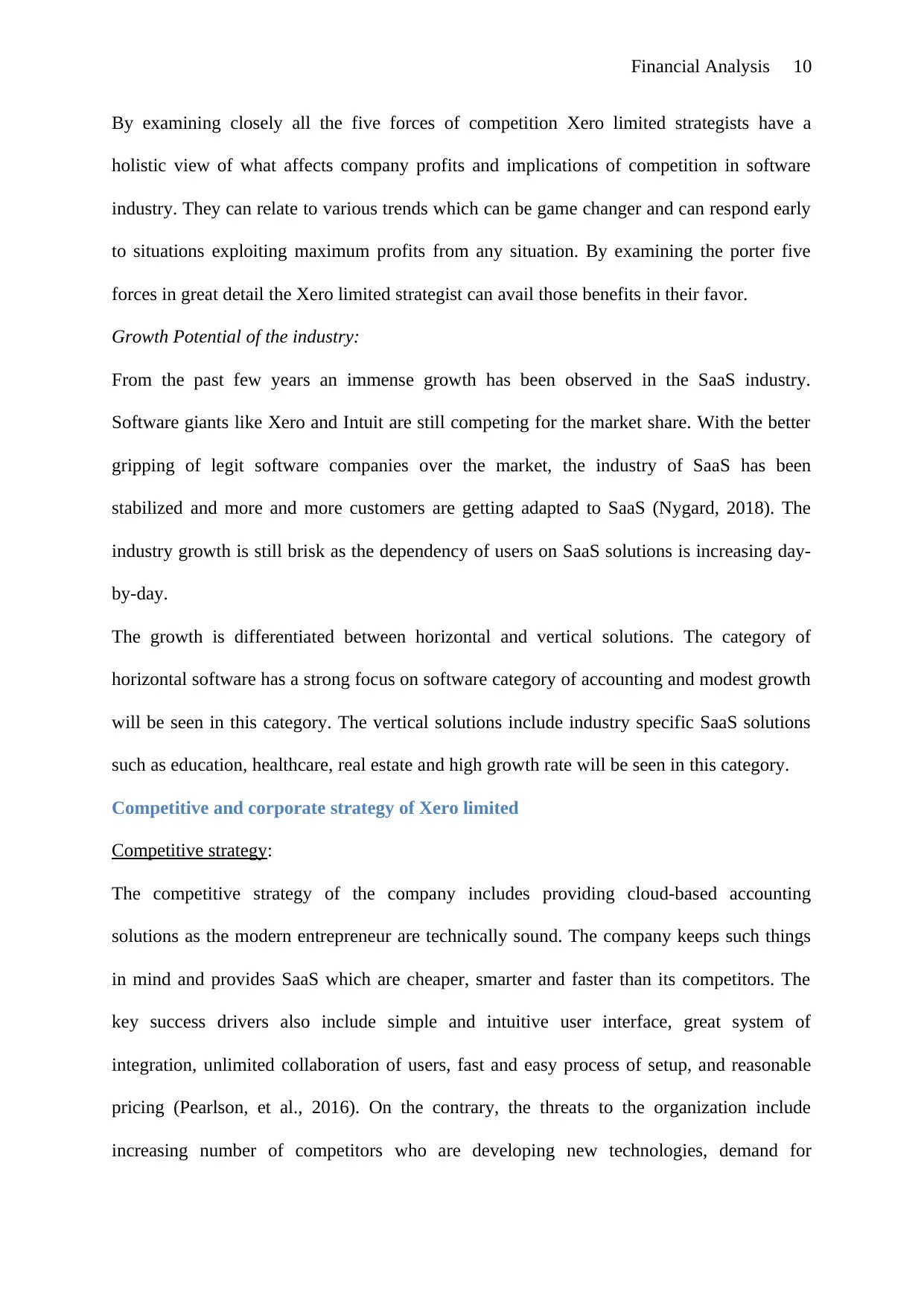
Financial Analysis 10
By examining closely all the five forces of competition Xero limited strategists have a
holistic view of what affects company profits and implications of competition in software
industry. They can relate to various trends which can be game changer and can respond early
to situations exploiting maximum profits from any situation. By examining the porter five
forces in great detail the Xero limited strategist can avail those benefits in their favor.
Growth Potential of the industry:
From the past few years an immense growth has been observed in the SaaS industry.
Software giants like Xero and Intuit are still competing for the market share. With the better
gripping of legit software companies over the market, the industry of SaaS has been
stabilized and more and more customers are getting adapted to SaaS (Nygard, 2018). The
industry growth is still brisk as the dependency of users on SaaS solutions is increasing day-
by-day.
The growth is differentiated between horizontal and vertical solutions. The category of
horizontal software has a strong focus on software category of accounting and modest growth
will be seen in this category. The vertical solutions include industry specific SaaS solutions
such as education, healthcare, real estate and high growth rate will be seen in this category.
Competitive and corporate strategy of Xero limited
Competitive strategy:
The competitive strategy of the company includes providing cloud-based accounting
solutions as the modern entrepreneur are technically sound. The company keeps such things
in mind and provides SaaS which are cheaper, smarter and faster than its competitors. The
key success drivers also include simple and intuitive user interface, great system of
integration, unlimited collaboration of users, fast and easy process of setup, and reasonable
pricing (Pearlson, et al., 2016). On the contrary, the threats to the organization include
increasing number of competitors who are developing new technologies, demand for
By examining closely all the five forces of competition Xero limited strategists have a
holistic view of what affects company profits and implications of competition in software
industry. They can relate to various trends which can be game changer and can respond early
to situations exploiting maximum profits from any situation. By examining the porter five
forces in great detail the Xero limited strategist can avail those benefits in their favor.
Growth Potential of the industry:
From the past few years an immense growth has been observed in the SaaS industry.
Software giants like Xero and Intuit are still competing for the market share. With the better
gripping of legit software companies over the market, the industry of SaaS has been
stabilized and more and more customers are getting adapted to SaaS (Nygard, 2018). The
industry growth is still brisk as the dependency of users on SaaS solutions is increasing day-
by-day.
The growth is differentiated between horizontal and vertical solutions. The category of
horizontal software has a strong focus on software category of accounting and modest growth
will be seen in this category. The vertical solutions include industry specific SaaS solutions
such as education, healthcare, real estate and high growth rate will be seen in this category.
Competitive and corporate strategy of Xero limited
Competitive strategy:
The competitive strategy of the company includes providing cloud-based accounting
solutions as the modern entrepreneur are technically sound. The company keeps such things
in mind and provides SaaS which are cheaper, smarter and faster than its competitors. The
key success drivers also include simple and intuitive user interface, great system of
integration, unlimited collaboration of users, fast and easy process of setup, and reasonable
pricing (Pearlson, et al., 2016). On the contrary, the threats to the organization include
increasing number of competitors who are developing new technologies, demand for
Paraphrase This Document
Need a fresh take? Get an instant paraphrase of this document with our AI Paraphraser
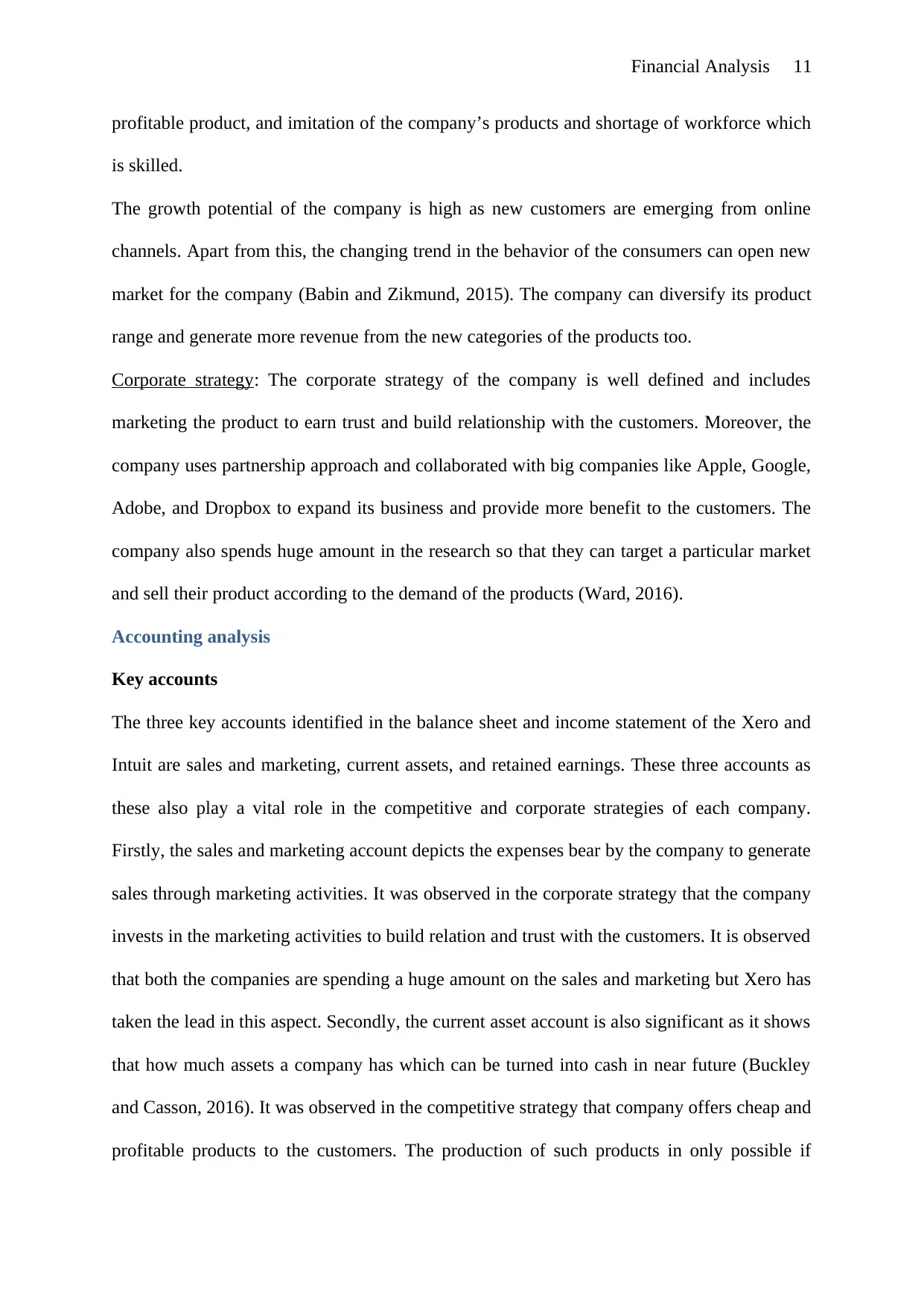
Financial Analysis 11
profitable product, and imitation of the company’s products and shortage of workforce which
is skilled.
The growth potential of the company is high as new customers are emerging from online
channels. Apart from this, the changing trend in the behavior of the consumers can open new
market for the company (Babin and Zikmund, 2015). The company can diversify its product
range and generate more revenue from the new categories of the products too.
Corporate strategy: The corporate strategy of the company is well defined and includes
marketing the product to earn trust and build relationship with the customers. Moreover, the
company uses partnership approach and collaborated with big companies like Apple, Google,
Adobe, and Dropbox to expand its business and provide more benefit to the customers. The
company also spends huge amount in the research so that they can target a particular market
and sell their product according to the demand of the products (Ward, 2016).
Accounting analysis
Key accounts
The three key accounts identified in the balance sheet and income statement of the Xero and
Intuit are sales and marketing, current assets, and retained earnings. These three accounts as
these also play a vital role in the competitive and corporate strategies of each company.
Firstly, the sales and marketing account depicts the expenses bear by the company to generate
sales through marketing activities. It was observed in the corporate strategy that the company
invests in the marketing activities to build relation and trust with the customers. It is observed
that both the companies are spending a huge amount on the sales and marketing but Xero has
taken the lead in this aspect. Secondly, the current asset account is also significant as it shows
that how much assets a company has which can be turned into cash in near future (Buckley
and Casson, 2016). It was observed in the competitive strategy that company offers cheap and
profitable products to the customers. The production of such products in only possible if
profitable product, and imitation of the company’s products and shortage of workforce which
is skilled.
The growth potential of the company is high as new customers are emerging from online
channels. Apart from this, the changing trend in the behavior of the consumers can open new
market for the company (Babin and Zikmund, 2015). The company can diversify its product
range and generate more revenue from the new categories of the products too.
Corporate strategy: The corporate strategy of the company is well defined and includes
marketing the product to earn trust and build relationship with the customers. Moreover, the
company uses partnership approach and collaborated with big companies like Apple, Google,
Adobe, and Dropbox to expand its business and provide more benefit to the customers. The
company also spends huge amount in the research so that they can target a particular market
and sell their product according to the demand of the products (Ward, 2016).
Accounting analysis
Key accounts
The three key accounts identified in the balance sheet and income statement of the Xero and
Intuit are sales and marketing, current assets, and retained earnings. These three accounts as
these also play a vital role in the competitive and corporate strategies of each company.
Firstly, the sales and marketing account depicts the expenses bear by the company to generate
sales through marketing activities. It was observed in the corporate strategy that the company
invests in the marketing activities to build relation and trust with the customers. It is observed
that both the companies are spending a huge amount on the sales and marketing but Xero has
taken the lead in this aspect. Secondly, the current asset account is also significant as it shows
that how much assets a company has which can be turned into cash in near future (Buckley
and Casson, 2016). It was observed in the competitive strategy that company offers cheap and
profitable products to the customers. The production of such products in only possible if
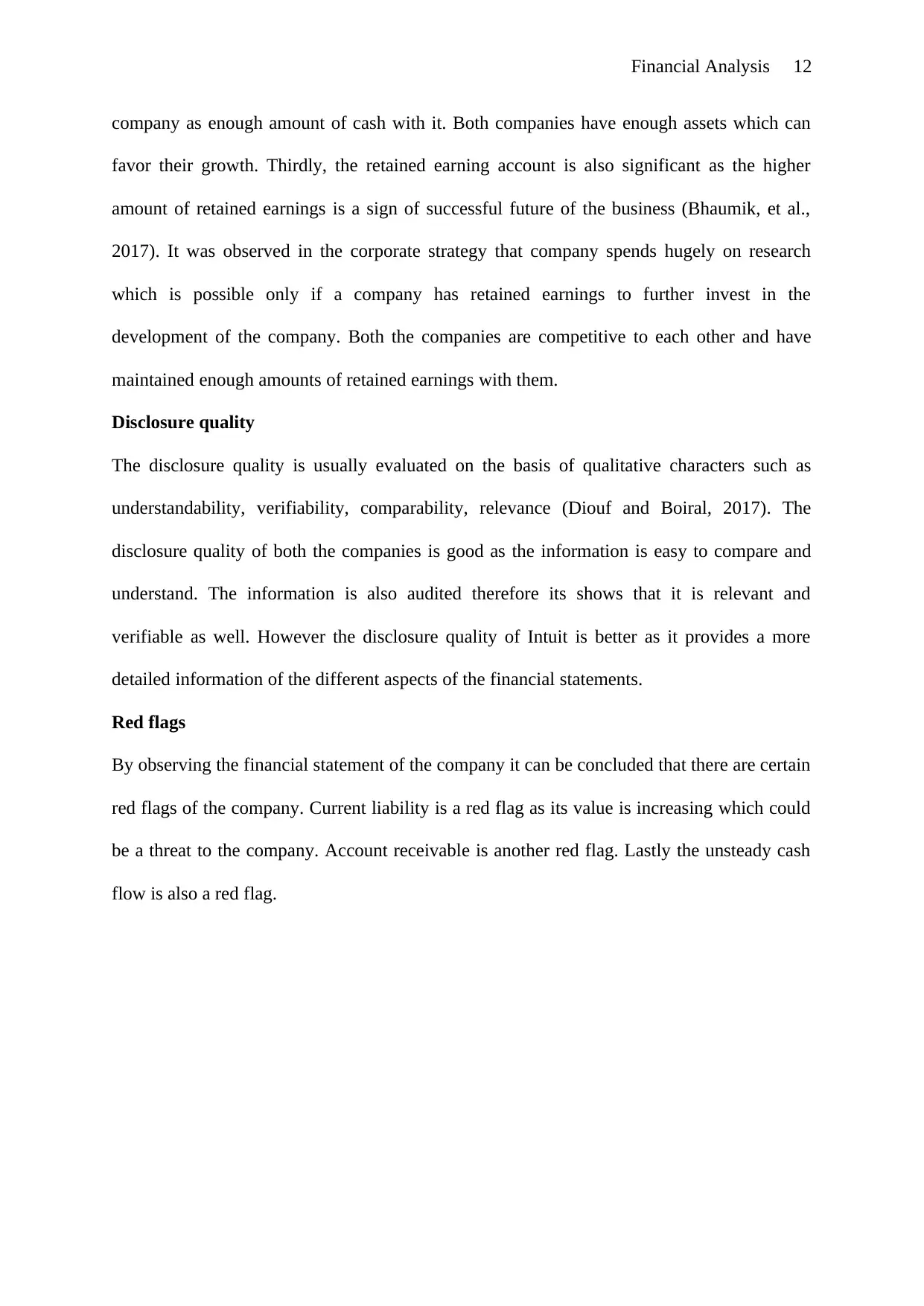
Financial Analysis 12
company as enough amount of cash with it. Both companies have enough assets which can
favor their growth. Thirdly, the retained earning account is also significant as the higher
amount of retained earnings is a sign of successful future of the business (Bhaumik, et al.,
2017). It was observed in the corporate strategy that company spends hugely on research
which is possible only if a company has retained earnings to further invest in the
development of the company. Both the companies are competitive to each other and have
maintained enough amounts of retained earnings with them.
Disclosure quality
The disclosure quality is usually evaluated on the basis of qualitative characters such as
understandability, verifiability, comparability, relevance (Diouf and Boiral, 2017). The
disclosure quality of both the companies is good as the information is easy to compare and
understand. The information is also audited therefore its shows that it is relevant and
verifiable as well. However the disclosure quality of Intuit is better as it provides a more
detailed information of the different aspects of the financial statements.
Red flags
By observing the financial statement of the company it can be concluded that there are certain
red flags of the company. Current liability is a red flag as its value is increasing which could
be a threat to the company. Account receivable is another red flag. Lastly the unsteady cash
flow is also a red flag.
company as enough amount of cash with it. Both companies have enough assets which can
favor their growth. Thirdly, the retained earning account is also significant as the higher
amount of retained earnings is a sign of successful future of the business (Bhaumik, et al.,
2017). It was observed in the corporate strategy that company spends hugely on research
which is possible only if a company has retained earnings to further invest in the
development of the company. Both the companies are competitive to each other and have
maintained enough amounts of retained earnings with them.
Disclosure quality
The disclosure quality is usually evaluated on the basis of qualitative characters such as
understandability, verifiability, comparability, relevance (Diouf and Boiral, 2017). The
disclosure quality of both the companies is good as the information is easy to compare and
understand. The information is also audited therefore its shows that it is relevant and
verifiable as well. However the disclosure quality of Intuit is better as it provides a more
detailed information of the different aspects of the financial statements.
Red flags
By observing the financial statement of the company it can be concluded that there are certain
red flags of the company. Current liability is a red flag as its value is increasing which could
be a threat to the company. Account receivable is another red flag. Lastly the unsteady cash
flow is also a red flag.
⊘ This is a preview!⊘
Do you want full access?
Subscribe today to unlock all pages.

Trusted by 1+ million students worldwide
1 out of 30
Related Documents
Your All-in-One AI-Powered Toolkit for Academic Success.
+13062052269
info@desklib.com
Available 24*7 on WhatsApp / Email
![[object Object]](/_next/static/media/star-bottom.7253800d.svg)
Unlock your academic potential
Copyright © 2020–2025 A2Z Services. All Rights Reserved. Developed and managed by ZUCOL.




